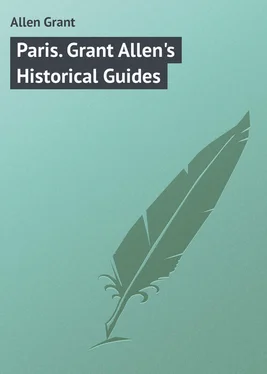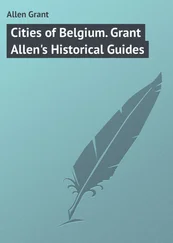Grant Allen - Paris. Grant Allen's Historical Guides
Здесь есть возможность читать онлайн «Grant Allen - Paris. Grant Allen's Historical Guides» — ознакомительный отрывок электронной книги совершенно бесплатно, а после прочтения отрывка купить полную версию. В некоторых случаях можно слушать аудио, скачать через торрент в формате fb2 и присутствует краткое содержание. ISBN: , Издательство: Иностранный паблик, Жанр: foreign_language, foreign_prose, на английском языке. Описание произведения, (предисловие) а так же отзывы посетителей доступны на портале библиотеки ЛибКат.
- Название:Paris. Grant Allen's Historical Guides
- Автор:
- Издательство:Иностранный паблик
- Жанр:
- Год:неизвестен
- ISBN:http://www.gutenberg.org/ebooks/49907
- Рейтинг книги:4 / 5. Голосов: 1
-
Избранное:Добавить в избранное
- Отзывы:
-
Ваша оценка:
- 80
- 1
- 2
- 3
- 4
- 5
Paris. Grant Allen's Historical Guides: краткое содержание, описание и аннотация
Предлагаем к чтению аннотацию, описание, краткое содержание или предисловие (зависит от того, что написал сам автор книги «Paris. Grant Allen's Historical Guides»). Если вы не нашли необходимую информацию о книге — напишите в комментариях, мы постараемся отыскать её.
Paris. Grant Allen's Historical Guides — читать онлайн ознакомительный отрывок
Ниже представлен текст книги, разбитый по страницам. Система сохранения места последней прочитанной страницы, позволяет с удобством читать онлайн бесплатно книгу «Paris. Grant Allen's Historical Guides», без необходимости каждый раз заново искать на чём Вы остановились. Поставьте закладку, и сможете в любой момент перейти на страницу, на которой закончили чтение.
Интервал:
Закладка:
Go out again. As you emerge from the door, observe the cold and bare side of the Panthéon, contrasted with the internal richness of St. Étienne. Curious view of the late Gothic portion of the church from the little Place on the N side. Return by the Rue Cujas and Rue St. Jacques, passing the Lycée Ste. Barbe, Lycée Louis-le-Grand, University, and other scholastic buildings, which give a good idea of the character of the quarter.
III
RENAISSANCE PARIS (THE LOUVRE)
[PARIS, which spread rapidly Southward at first, was somewhat slower in its Northwarddevelopment. Nevertheless, by the time of Philippe Auguste, the Town La Ville– the commercial portion N of the river – more than equalled the learned district on the S side. This central northern region, however, containing the Hôtel de Ville, St. Eustache, and some other important buildings, I purposely postpone to the consideration of the Louvreand its neighbourhood, which, though later in date, form the heart and core of Renaissance Paris – the Paris of François Ier and his splendour-loving successors.
Most of the buildings we have hitherto considered are mediæval and Gothic. The Louvre introduces us at once to a new world – the world of the Renaissance. The transition is abrupt. In Italy, and especially in Florence, the Renaissance was a natural growth ; in France it was a fashion. It came in, full-fledged, without history or antecedents. To trace its evolution, one must follow it out in detail in Florence and Venice. There, it grows of itself, organically, by gradual stages. But in France, Gothic churches and mediæval châteaux give place at once, with a bound, to developed Renaissance temples and palaces. The reason for this fact is, that the French kings, from Charles VIII onward to Henri IV, were thoroughly Italianate. They fought, travelled, and married in Italy, to parts of which they laid claim; and being closely allied with the Medici and other Italian families, – husbands of Medici wives, sons of Medici mothers, – they introduced at once into France the developed products of the Italian Renaissance. At the same time the increased and centralized power of the Crown enabled them to build magnificent palaces, like the Louvre and Fontainebleau; and to this artificial impulse is mainly due the sudden outburst of art in France under François Ier and his immediate successors.
It is impossible to characterize the Renaissancein a few short sentences. In one aspect, it was a return from Gothicismto Classical usage, somewhat altered by the new conditions of life. At first you will probably only notice that in architecture it substituted round arches for pointed, and introduced square doors and windows; while in other arts it replaced sacred and Christian subjects and treatment by mythological and secular. But, in contrast with mediævalism, it will reveal itself to you by degrees as essentially the dawn of the modern spirit.
The Louvreis the noblest monument of the French Renaissance. From the time of St. Louis onward, the French kings began to live more and more in the northern suburb, the town of the merchants, which now assumed the name of La Ville, in contradistinction to the Cité and the Université. Two of their chief residences here were the Bastille and the Hôtel St. Paul, both now demolished – one, on the Place so called, the other, between the Rue St. Antoine and the Quai des Célestins. But from a very early period they also possessed a château on the site of the Louvre, and known by the same name, which guarded the point where the wall of Philippe Auguste abutted on the river. François Ier decided to pull down this picturesque turreted mediæval castle, erected by Philippe Auguste and altered by Charles V. He began the construction in its place of a magnificent Renaissance palace, which has ever since been in course of erection. Its subsequent growth, however, is best explained opposite the building itself, where attention can be duly called to the succession of its salient features. But a visit to the exterior fabric of the Louvre should be preceded by one to St. Germain l’Auxerrois, the parish church, and practically the chapel, of the old Louvre, to which it stood in somewhat the same relation as the Ste. Chapelle to the home of St. Louis. Note, however, that the church was situated just within the ancient wall, while the château lay outside it. The visitor will doubtless be tolerably familiar by this time with some parts at least of the exterior of the Louvre; but he will do well to visit it now systematically, in the order here suggested, so as to gain a clear general idea of its history and meaning.]
A. THE FABRIC
Go along the Rue de Rivoli, past the Palais Royal, till you reach the Rue du Louvre. Turn down it, with the Louvre on your right. To your left stands a curious composite building, with a detached belfry in the centre, and two wings, as it seems, one on either side. The southernmost wing is the old church of St. Germain l’Auxerrois, the sole remnant of the earliest Louvre; the northernmost wing is the modern Mairie of the 1st Arrondissement, unhappily intended to “harmonize” with it. The real result is, that the modern building kills the old one. The belfry was designed to fill up the gap between the two. Its effect is disastrous.
The church is older than the oldest Louvre. St. Germanus, Bishop of Auxerre (A.D. 430), was almost one of the first generation of Gallic saints, celebrated for his visit to Britain, where he assisted in gaining the Hallelujah victory over the heathen invaders. A church on this site is said to have been erected in his honour as early as the days of Chilperic. Sacked by the Normans, it was re-erected in something like its present form in the 12th century, but received many subsequent additions.
The beautiful porch, which we first examine, is of much later date, having been added in 1431 by Jean Gaussel, at a time when the old château of the Louvre had become one of the principal residences of the French kings, in order to give greater dignity, and to afford a covered approach for the royal worshippers to what was practically their own chapel. It therefore contains (restored) statues, in niches, relating especially to the royal and local Saints of Paris, whose names are beneath them: – St. Cloud, the Princess Ste. Clotilde, Ste. Radégonde of France, St. Denis, St. Marcel, St. Germain himself, St. Landry, Ste. Isabelle, Ste. Bathilde, St. Jean de Valois, and others. The saints of the royal house are distinguished by crowns or coronets. Two of these statues are old: St. Francis, at the south end, and St. Mary of Egypt, nude, with her long hair, and the three loaves which sustained her in the desert, on the second north pillar. The modern frescoes, destroyed, are by Mottez.
Observe the congruity of all these saints to the church and the château . St. Landry or Landeric, an early Frankish bishop of Paris, was buried within, and his shrine was a place of pilgrimage. St. Marcel was also a bishop of Paris. St. Cloud was a holy anchorite whose cell was in the wood which occupied the site of the palace (now destroyed) that bears his name. All these saints are therefore closely bound up with the town of Paris and the royal family. You must never forget this near alliance in France between the church and the crown: it colours all the architecture of the early period.
Within the porch, we come to the main façade, of the 13th century. R and L, two sainted bishops of Auxerre, successors of St. Germain. Central portal, a queen, a king (probably Childebert and Ultrogothe, the original Frankish founders), St. Vincent; then St. Germain himself, and Ste. Geneviève, with the usual devil and candle, and her attendant angel, etc. On the pier, Madonna and Child, under a canopy. The tympanum had formerly the usual relief of the Last Judgment, now destroyed, and replaced by a fresco. Reminiscences of its subject still remain in the quaint figures to R and L on the arch, at its base, representing respectively, with childish realism, the Jaws of Hell and Abraham’s Bosom, to which the wicked and the just were consigned in the centre.
Читать дальшеИнтервал:
Закладка:
Похожие книги на «Paris. Grant Allen's Historical Guides»
Представляем Вашему вниманию похожие книги на «Paris. Grant Allen's Historical Guides» списком для выбора. Мы отобрали схожую по названию и смыслу литературу в надежде предоставить читателям больше вариантов отыскать новые, интересные, ещё непрочитанные произведения.
Обсуждение, отзывы о книге «Paris. Grant Allen's Historical Guides» и просто собственные мнения читателей. Оставьте ваши комментарии, напишите, что Вы думаете о произведении, его смысле или главных героях. Укажите что конкретно понравилось, а что нет, и почему Вы так считаете.












